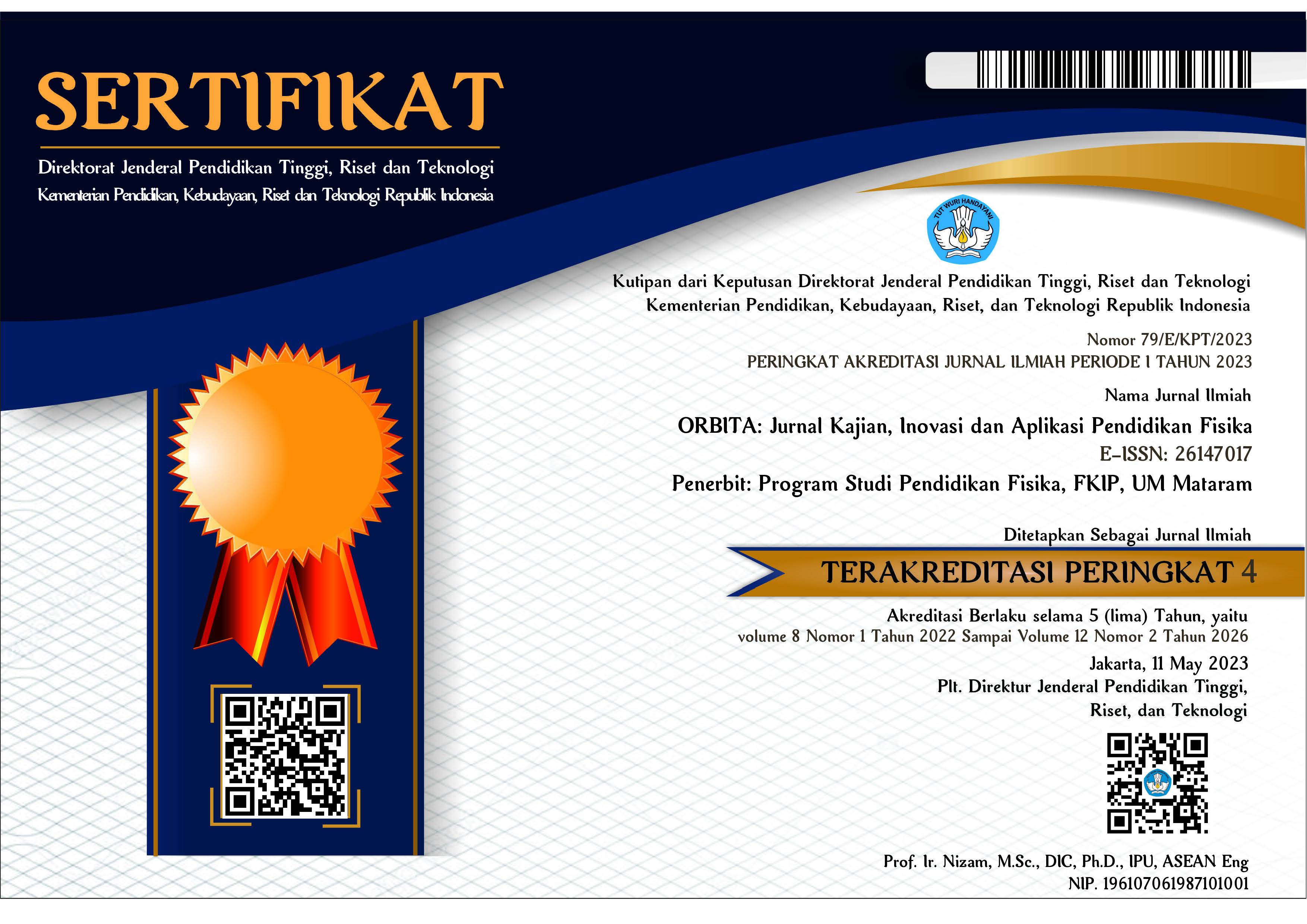ANALISIS PEMANFAATAN PASIR BESI DAN BATU APUNG SEBAGAI AGREGAT BETON PERISAI RADIASI SINAR-X
Abstract
ABSTRAK
Perisai radiasi dengan nilai koefisien atenuasi linier tinggi dan harga bahan yang ekonomis menjadi pertimbangan dalam pengembangan perisai radiasi. Bahan yang berpotensi untuk dikembangkan adalah pasir besi dan batu apung. Dalam penelitian ini dilakukan investigasi pengaruh variasi komposisi campuran agregat pasir besi-batu apung terhadap nilai densitas dan nilai koefisien atenuasi linier serta pengaruh ketebalan beton terhadap kemampuannya dalam menyerap radiasi sinar-x. Pengujian nilai koefisien atenuasi linier menggunakan berkas foton LINAC berenergi 6 MV dan 10 MV. Pencocokan kurva regresi linier (linear fitting curve) digunakan dalam penentuan nilai koefisien atenuasi linier. Hasil penelitian menunjukkan bahwa semakin besar nilai densitas beton uji maka nilai koefisien atenuasi liniernya semakin meningkat. Nilai densitas beton tertinggi dimiliki oleh material beton C5 yaitu 2,03 g/cm3. Material beton C5 memiliki nilai koefisien atenuasi linier tertinggi yaitu 0,0524 cm-1 dengan nilai HVL 13,23 cm dan 0,0419 cm-1 dengan nilai HVL 16,54 cm untuk energi 6 MV dan 10 MV.
Kata kunci: beton; HVL; koefisien atenuasi linier; sinar-x.
ABSTRACT
Radiation shields with high linear attenuation coefficient values and economical material prices are considered in the development of radiation shields. Materials that have the potential to be developed are iron sand and pumice. In this research, we investigated the effect of variations in the composition of the iron sand-pumice aggregate mixture on the density value and the linear attenuation coefficient value as well as the effect of concrete thickness on its ability to absorb x-ray radiation. Testing the value of the linear attenuation coefficient using LINAC photon beams with energies of 6 MV and 10 MV. Linear fitting curve is used in determining the linear attenuation coefficient value. The results showed that the greater the density value of the test concrete, the higher the linear attenuation coefficient value. The highest concrete density value is owned by C5 concrete material, which is 2.03 g/cm3. C5 concrete material has the highest linear attenuation coefficient value of 0.0524 cm-1 that other sample with an HVL value of 13.23 cm and 0.0419 cm-1 with an HVL value of 16.54 cm respectively for 6 MV and 10 MV energies.
Keywords: concrete; HVL; linear attenuation coefficient; X-ray.
Keywords
Full Text:
PDFReferences
Abdullah, M.A.H., Rashid, R. S. M., Amran, M., Hejazi, F., Azreen, N.M., Fediuk, R., Voo, Y.L., Vatin, N. I., and Idris, M. I. (2022). Recent Trends in Advanced Radiation Shielding Concrete for Contruction of Facilities: Materials and Properties. Polymers 2022, 14, 2830.
https://doi.org/10.3390/polym14142830.
Agar O., Tekin H. O., Sayyed M. I., Korkmaz M. E., Culfa O., and Ertugay C. (2019). Experimental investigation of photon attenuation behaviors for concretes including natural perlite mineral, Results in Physics 12, 237-243.
Akhadi, M. (2000). Dasar-Dasar Proteksi Radiasi. Jakarta: Rineka Cipta.
Almurayshid, M., Alsagabi, S., Alssalim, S., Alotaibi, Z., Almsalam, R. (2021). Feasibility of polymer-based composite materials as radiation shield. Radiation Physics and Chemistry Volume 183, 109425, https://doi.org/10.1016/j.radphyschem.2021.109425.
Askarian, M., Aval, S. F., Joshaghani, A. (2019). A Comprehensive Experimental Study on The Performance of Pumice Powder in Self-Compacting Concrete (SCC). Journal of Sustainable Cement-Based Materials, Vol. 7 (6), 340-356. https://doi.org/10.1080/21650373.2018.1511486.
Attia. M. M., Abdelsalam, B. A., Amin, M., Agwa, I. S., Abdelmagied, M. F. (2022). Metal-Nails Waste and Steel Slag Aggregate as Alternative and Eco-Friendly Radiation Shielding Composites. Buildings 2022, 12, 1120, 1-14.
Aziz, F. (2018). Penelitian dan Pengembangan Material Struktur Reaktor Maju. Jurnal Pengembangan Energi Nuklir, Vol. 20. No.1, 41-51.
Azreen N.M., Rashid R.S.M., Haniza M., Voo Y.L., Amran Y.H.M. (2018). Radiation shielding of ultra-high-performance concrete with silica sand, amang and lead glass. Construction and Building Materials, 172, 370–377. https://doi: 10.1016/j.conbuildmat.2018.03.243.
Dahlan, K., Haryati, E., and Aninam, Y. S. (2018). The use of Papuan iron sand and river sand for fine aggregate in mortar for nuclear radiation shield application. Journal of Physics. Conf. series 997 012023. https://doi.org/10.1088/1742-6596/997/1/012023.
Fitler. (2018). Tesis: Pembuatan Dan Karakterisasi Perisai Radiasi Sinar-X Berbasis Polyester Timbal Asetat Sebagai Salah Satu Alternatif Pengganti Kaca Timbal. Medan: Universitas Sumatera Utara.
Gunoglu, K., Akkurt, I. (2021). Radiation shielding properties of concrete containing magnetite. Progress in Nuclear Energy, Volume 137, 2021, Article 103776. https://doi.org/10.1016/j.pnucene.2021.103776.
Hannachi, E.; Mahmoud, K.A.; Almuqrin, A.H.; Sayyed, M.I.; Slimani, Y. (2022). Evaluation of the Radiation-Protective Properties of Bi (Pb)–Sr–Ca–Cu–O Ceramic Prepared at Different Temperatures with Silver Inclusion. Materials 2022, 15, 1034. https://doi.org/10.3390/ma15031034
Khaldari, R., Asghar Mesbahi, A., Kara, U. (2016). Monte Carlo Calculation of Shielding Properties of Newly Developed Heavy Concretes for Megavoltage Photon Beam Spectra Used In Radiation Therapy, Iranian Journal of Medical Physics Vol. 13, No. 4, 250-260.
Kusumaningtyas, M. P. (2017). Skripsi: Analisis Struktur Nano Batu Apung Lombok Menggunakan Metode BET (Brunauer-Emmett-Teller). Surabaya: Fakultas Matematika dan Ilmu Pengetahuan Alam, Institut Teknologi Sepuluh Nopember.
Moharram B.M., Nagy M.E., Shaat M.K., Sayed A.R.E., Fayiz M., Dwidar S.A., Dorrah M.E., (2020). Performance of lead and iron oxides nanoparticle materials on shielding properties for γ-rays. Radiation Physics and Chemistry. Vol. 173:108880. https://doi: 10.1016/j.radphyschem.2020.108880.
Tanyildizi, M., Gokalp, I. (2023). Utilization of pumice as aggregate in the concrete: A state of art. Construction and Building Materials, Vol. 377, 131102. https://doi.org/10.1016/j.conbuildmat.2023.131102.
Turhan, M.F., Akman, F., Kacal, M.R., Polat, H., Demirkol, I. (2023). A study for gamma-ray attenuation performances of barite filled polymer composites. Applied Radiation and Isotopes, Volume 191, 110568, https://doi.org/10.1016/j.apradiso.2022.110568.
Tyagi, G., Singhal, A., Routroy, S., Bhunia, D., and Lahoti, M. (2021). Radiation Shielding Concrete with alternate constituents: An approach to address multiple hazards, Journal of Hazardous Materials, Volume 404, Part B, 124201 https://doi.org/10.1016/j.jhazmat.2020.124201.
Wijaya, J., Sikomena, E. F., Budi, G. S., Koentjoro, H. (2018). High Density Concrete dengan Menggunakan Barit sebagai Penahan Radiasi. Jurnal Dimensi Pratama Teknik Sipil, Vol. 7 No.1, 195-202.
Wirawan, R., Qomariyah, N., Ardianto, T., and Kurniawidi, D. W. (2021). Analysis of the radiation parameters of pumice constituent compounds using XCOM. Journal of Physics: Conference Series 1816 (2021) 012116 IOP Publishing https://doi:10.1088/1742-6596/1816/1/012116.
Wu, Y., Cao Y., Wu Y., and Li D. (2020). Mechanical Properties and Gamma-Ray Shielding Performance of 3D-Printed Poly-Ether-Ether-Ketone/Tungsten Composites, Materials 2020, 13, 4475, 1-22. https://doi:10.3390/ma13204475.
DOI: https://doi.org/10.31764/orbita.v9i1.14731
Refbacks
- There are currently no refbacks.

This work is licensed under a Creative Commons Attribution-ShareAlike 4.0 International License.
______________________________________________________
ORBITA: Jurnal Pendidikan dan Ilmu Fisika
p-ISSN 2460-9587 || e-ISSN 2614-7017
This work is licensed under a Creative Commons Attribution-ShareAlike 4.0 International License.
EDITORIAL OFFICE:




























